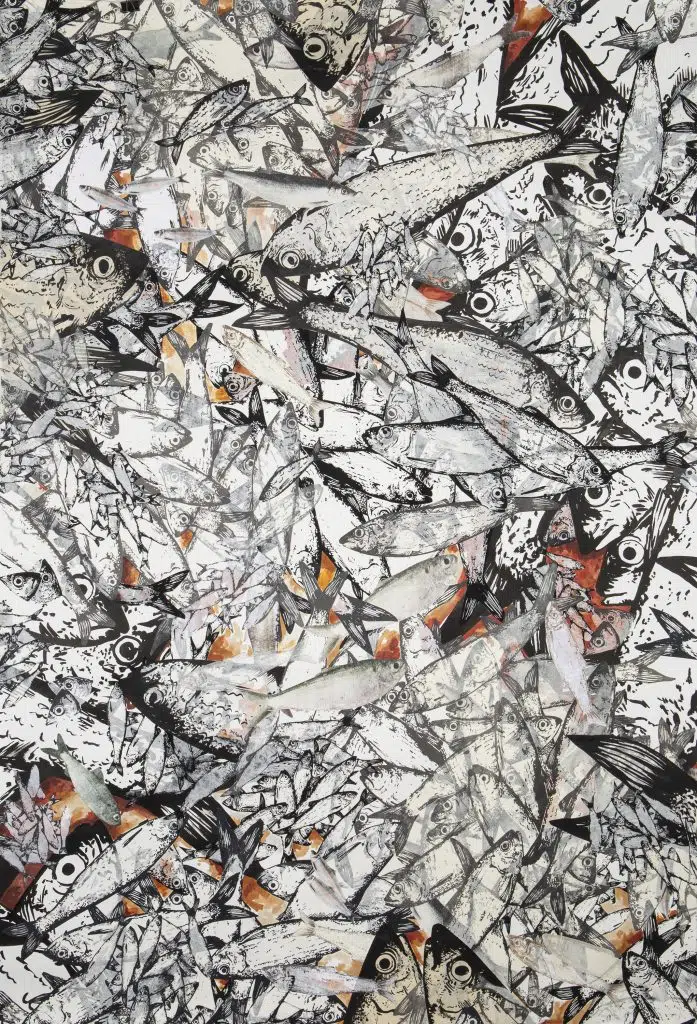The following article is part of the Art Forward series from the Rahr-West Art Museum. Written by Natasha F. Khan, Collections Assistant.
“I see education; I see an opportunity to help people recognize the value, importance and the current events that are impacting the Great Lakes. I just see it as a tool.” – Geo Rutherford, 2021, LINK
If you live in the Manitowoc area or near another large lake, you know that living close to a lake can be a beautiful yet frustrating experience. Having close access to a lake and being able to see it every day is wonderful. On the other hand, living so close to a lake we see up close what happens when we don’t take care of our beaches and the environment. Artist Geo Rutherford’s focus on the Great Lakes explores some of these topics.
On April 24th a new exhibit opened at the Rahr West Art Museum, Geo Rutherford: On the Threshold of the Great Lakes. This exhibit will remain open until July 10th. There will be an open house on Saturday, April 30th and Sunday, May 1st from 11am-4pm with the artist there to meet with visitors, talk about the exhibit, and discuss the pieces. Make sure to stop by!
Geo Rutherford is an artist who creates prints, artist’s books, and large-scale mixed media pieces. Her focus is the Great Lakes with an emphasis on invasiveness, impermanence, and the unseen. She is also an adjunct lecturer at the University of Wisconsin-Milwaukee, an Art Director at Blue Lake Fine Arts Camp in Muskegon County, Michigan, and co-chairs a non-profit, #whyyoumatter.
Watch the movie Um Yes, Hello (Geo Rutherford, 2021) by Thomas Sawyer to get a more in-depth look at Geo and her amazing work!
Geo shared her insights on the exhibit, the Great Lakes, and art with us.

What inspired you to create the pieces on exhibit?
The topic of my thesis [for UW-Milwaukee] was first conceived along the Great Lakes coast where the waves meet the beach on the margin of the shore. As a child brought up in Colorado, the first time I saw Lake Michigan, I thought it must be an ocean. This was not a surprising response, considering that the Great Lakes have frequently been called “inland seas” or “sweetwater seas.” Calling them lakes is like calling the Rockies “hills.” Over the last two years, I have attempted to appreciate their sheer magnitude by visiting every lake and spending time on their shores. That journey has taken me around the Great Lakes: from huffing my way up the Sleeping Bear Dunes and kayaking amongst the Apostle Islands to walking along the cliffs at Pictured Rocks, staring up at Door County’s towering escarpment and being engulfed in the mist from the Niagara Falls. While the Great Lakes are the largest freshwater lake system in the world, their size is difficult to interpret from the shore or to perceive on a map. They span 95,160 square miles (246,463 square kilometers) and stretch 750 miles (1,200 km) from west to east. The total square mileage is larger than the state of Texas. The lakes are suspended between the United States and Canada, holding a combined total of water that is 20% of the world’s available, unfrozen fresh water. Even knowing these facts for years and visiting each lake in person, I struggle to grasp their immense impression on this Earth. Comprehending the sheer scale of the Great Lakes has baffled generations of people since the glaciers retreated 10,000 years ago. As an artist and a researcher, I come to witness changes to the shoreline as well as collecting various specimens the lake has turned over to the sandy perimeter. Amongst the detritus, there is evidence of greater issues impacting the Great Lakes that have been relinquished to the shore. My passion to educate about the lakes through my work has inspired this show and now drives the work I continue to make.
How did you get into printmaking?
From an artist’s perspective, these invasive species are a crucial storytelling device for artwork that informs the viewer of the lake’s current situation. Through the inherently repetitive nature of printmaking, I am able to mimic these creatures’ likeness and replicate their detrimental multiplication. Each image I make can transform into an abundance of prints on a wide range of eastern papers. Printmaking’s penchant for repetition results in hundreds of screenprinted lamprey with gaping mouths, block prints of zebra mussels in a congested throng and slippery alewives folded into a mound. Once I’ve made these prints, they are carefully cut out, leaving behind a trail of paper scraps and fragments. The result is stacks of prints in my studio that mimic the piles of mussel shells on the shore. Hundreds of lamprey, alewives, and mussels peek out at me from studio shelves, a veritable cacophony of invasive prints.
Prints are not restrained in two dimensions as I fold, crease, crinkle, and morph my collaged prints into handheld paper boats. The process begins with cutting a textured eastern paper into squares. Most at eleven inches on all sides, but many shrink and expand, resulting in large boats alongside boats smaller than your palm. I begin by screen printing both sides: one covered with tiny critters and the other a swath of textured blue. Layered on top of the critter print, I block print the prominent invasive species from my other colleges. I ink each block up and print the image until the ghost is a shadow on the paper, barely visible against the grey screen print of the critters. Each sheet is a collage of these prints, carefully folded into a small paper boat. The textured blue print stands out in the belly of the boat while the critters swarm along the outside, stark against the white paper.
What do you think people can do to better the health of the Great Lakes?
Vote for those who actively campaign to protect our Great Lakes. We are lucky to be alive on this planet while these lakes are here, in our backyard. We should be fighting to protect them at all costs.
Is there anything you want visitors to know about the exhibit or your work?
The show display is divided, like the margin of the shore between the beach, the water, and everything passed between. The wall closest to Lake Michigan displays “Beach Detritus” manière noire lithographs alongside three giant glass tubes containing sand, found material, and water from Manitow’s local beach. The prints showcase how the material is found on the shore, pushed into shapes amongst the sand, while the tubes clearly separate and define the threshold. The glass tubes are precariously balanced on the wooden shelf, each tube weighing up to ten pounds, mockingly created to mimic the margin of the shore.
The center of the gallery is the space between water and sand, where the water leaves hints and clues scattered in the sand. The found objects from the shore have been carefully organized and displayed in unique handmade shelves. One hundred and eighty-four tubes showcase three years’ worth of beach finds from all the Great Lakes. A veritas of found material, showcased as a mockery of museum collections, organized by type and material but also by aesthetics and instinct. Each tube is unique, a small 360 view of the material within, viewed easily from both sides of the gallery.
The installation of paper boats is suspended by delicate strings waiting to tangle. As you walk past the installation, the mussels crunch under your feet and the hanging boats quiver. The paper vessels cast shadows on the walls as they hover, suspended above an artificial beach. From below, looking up, a viewer can see the printed impressions of the invasive species. Looking down, shades of blue gaze back, appearing innocuous, while containing the agents of change in their bellies.
The opposing wall showcases the three large collages of lamprey, alewives and mussels respectively. These non-native species are the main actors of change in the last 200 years for the Great Lakes ecosystems. The impact of their presence is irreversible since they have had such a detrimental impact on the ecosystems and are blamed for many losses to native species. This show contains work that displays the past, current, and future issues for the Great Lakes. Just like when I stand on the shore and look out at the water, there are still many unknowns when it comes to these waters at the heart of North America.
Make sure to check out and follow her:
- Instagram: @someprintlife
- Email: geo.rutherford@gmail.com
- TikTok: https://www.tiktok.com/@geodesaurus
- https://www.georutherford.com/
Geo Rutherford will be at the Rahr-West Art Museum this Saturday and Sunday, April 30th and May 1st from 11:00 am – 4:00 pm to meet and talk with visitors about her exhibit. Please join us. The Rahr-West Art Museum is a Department of the City of Manitowoc. For more information and museum hours see www.rahrwestartmuseum.org.







